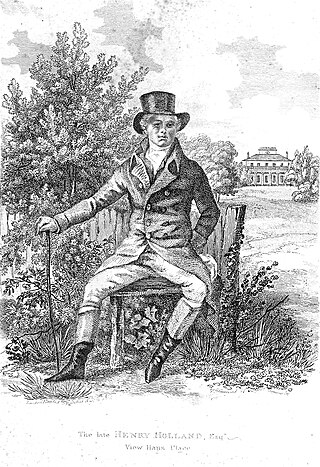
John Bacon was a British sculptor who worked in the late 18th century. Bacon has been reckoned the founder of the British School of sculpture. He won numerous awards, held the esteem of George III, and examples of his works adorn St Paul's Cathedral and Westminster Abbey in London, Christ Church, Oxford, Pembroke College, Oxford, Bath Abbey and Bristol Cathedral.

Thomas Banks was an important 18th-century English sculptor.

Sir Francis Leggatt Chantrey was an English sculptor. He became the leading portrait sculptor in Regency era Britain, producing busts and statues of many notable figures of the time. Chantrey's most notable works include the statues of King George IV ; King George III (Guildhall), and George Washington. He also executed four monuments to military heroes for St Paul's Cathedral, London. He left the Chantrey Bequest for the purchase of works of art for the nation, which was available from 1878 after the death of his widow.

James Wyatt was an English architect, a rival of Robert Adam in the neoclassical and neo-Gothic styles. He was elected to the Royal Academy in 1785 and was its president from 1805 to 1806.

Joseph Wilton was an English sculptor. He was one of the founding members of the Royal Academy in 1768, and the academy's third keeper. His works are particularly numerous memorialising the famous Britons in Westminster Abbey.

William Behnes was a British sculptor of the early 19th century.

John Raphael Smith was a British painter and mezzotinter. He was the son of Thomas Smith of Derby, the landscape painter, and father of John Rubens Smith, a painter who emigrated to the United States.

Henry Holland was an architect to the English nobility.
The Thames Navigation Commission managed the River Thames in southern England from 1751 to 1866. In particular, they were responsible for installing or renovating many of the locks on the river in the 18th and early 19th centuries

Giuseppe Ceracchi was an Italian sculptor, active in a Neoclassic style in Italy, England and the nascent United States, who was a passionate republican during the American and French revolutions. He is remembered for his portrait busts of prominent British and American individuals.

John Cheere (1709–1787) was an English sculptor, born in London. The younger brother of the sculptor Sir Henry Cheere, he was originally apprenticed as a haberdasher from 1725 to 1732.

Thomas Elrington was an Irish academic and bishop. He was Donegall Lecturer in Mathematics (1790-1795) at Trinity College Dublin (TCD). While at TCD he also served as Erasmus Smith's Professor of Mathematics (1795–1799) and as Erasmus Smith's Professor of Natural and Experimental Philosophy (1799–1807). Later, he was Provost of Trinity College Dublin (1811-1820), then Bishop of Limerick, Ardfert and Aghadoe (1820-1822), and finally Bishop of Ferns and Leighlin till his death in Liverpool in 1835.

Samuel Joseph was a British sculptor, working in the early 19th century.

William Tyler was an English sculptor, landscaper, and architect, and one of the three founding members of the Royal Academy, in 1768. He was Director of the Society of Artists.

Peter Rouw II was a London-based sculptor specialising in bas-reliefs in marble, often in the form of mural church monuments, and in wax miniature portraits, often of a pink hue on black glass. He designed medals, including one of William Wilberforce, and also made a few marble busts. He exhibited at the Royal Academy of Arts. In 1807 Rouw was appointed modeller of cameos and gems to the Prince Regent.

Peter Turnerelli (c.1772–1839) was an Irish-born sculptor of Italian descent working in Britain in the early 19th century.
Peter Francis Chenu (1760–1834) was a British sculptor of French birth working in the late 18th and early 19th century.

John Francis Moore was a sculptor who was active in late 18th century Britain. His works include two memorials in Westminster Abbey.
John Deval (1701–1774) was an 18th-century British sculptor and Master Mason, as was his namesake son (1728–1794). He was Chief Mason to the Crown and was the mason for the Tower of London and Royal Mews.















